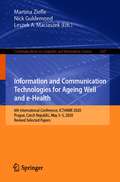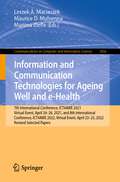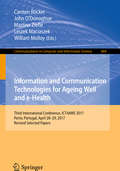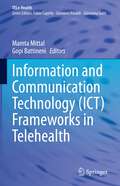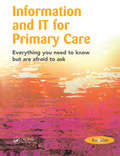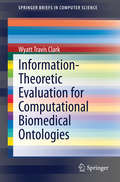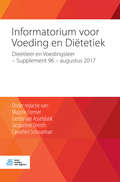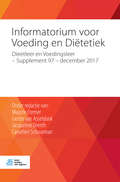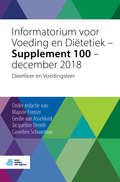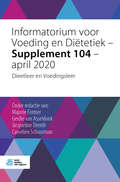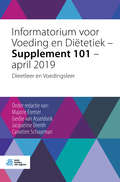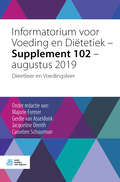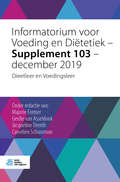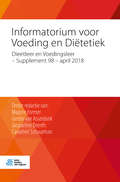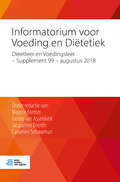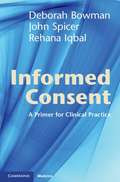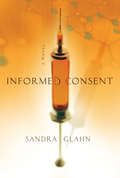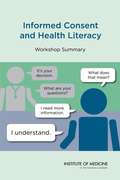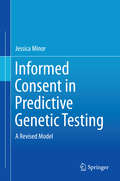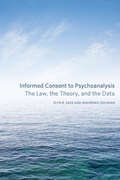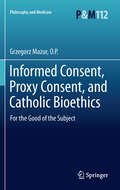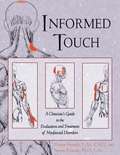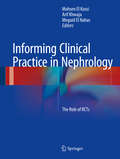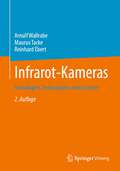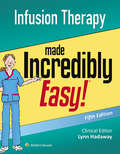- Table View
- List View
Information and Communication Technologies for Ageing Well and e-Health: 6th International Conference, ICT4AWE 2020, Prague, Czech Republic, May 3–5, 2020, Revised Selected Papers (Communications in Computer and Information Science #1387)
by Leszek A. Maciaszek Martina Ziefle Nick GuldemondThis book constitutes the revised, selected and extended papers of the 6th International Conference on Communication Technologies for Ageing Well and e-Health, ICT4AWE 2020, held in Prague, Czech Republic, in May 2020. Due to the COVID-19 pandemic the conference was held online. The 7 full papers presented were carefully reviewed and selected from 50 submissions. The papers present most recent research on best practices, innovation and technical improvements in the fields of age and health care, education, psychology, social coordination and ambient assisted living.
Information and Communication Technologies for Ageing Well and e-Health: 7th International Conference, ICT4AWE 2021, Virtual Event, April 24–26, 2021, and 8th International Conference, ICT4AWE 2022, Virtual Event, April 23–25, 2022, Revised Selected Papers (Communications in Computer and Information Science #1856)
by Leszek A. Maciaszek Martina Ziefle Maurice D. MulvennaThis book constitutes the refereed post-conference proceedings of the 7th and the 8th International Conference on Big Data Technologies and Applications, ICT4AWE 2021 and ICT4AWE 2022, held in April 24–26, 2021 and April 23–25, 2022. Due to COVID-19 pandemic both conferences were held virtually.The 21 full papers of ICT4AWE 2021 and ICT4AWE 2022 were selected from 80 submissions and present all big data technologies, such as Aging Well - Social and Human Sciences Perspective; Telemedicine and Independent Living; Digital Health and e-health.
Information and Communication Technologies for Ageing Well and e-Health: Third International Conference, ICT4AWE 2017, Porto, Portugal, April 28-29, 2017, Revised Selected Papers (Communications in Computer and Information Science #869)
by Carsten Röcker Martina Ziefle Leszek Maciaszek William Molloy John O’DonoghueThis book constitutes the thoroughly refereed proceedings of the third International Conference on Communication Technologies for Ageing Well and e-Health, ICT4AWE 2017, held in Porto, Portugal in April 2017. The 10 full papers presented were carefully reviewed and selected from 32 submissions. The papers aim at contributing to the understanding of relevant trends of current research on ICT for Ageing Well and eHealth including the collection and evaluation of day/night end user behavior patterns through the adoption of wearable technologies.
Information and Communication Technology (TELe-Health)
by Mamta Mittal Gopi BattineniThis book aims to explore technology solutions and systems to help people in remote areas in order to improve medical care. Access to health care services is critical to good health, but residents of remote areas face a variety of access barriers. The obstacles faced by health care providers and patients in rural areas are very different from those in urban areas. This could be caused by economic factors, cultural and social differences, educational deficiencies, lack of recognition by legislators, and the sheer isolation of living in inland areas, all of which conspire to create health care disparities and hinder people living in inland areas in their struggle to lead normal, healthy lives. Based on available analyses, further progress is needed to promote appropriateness of care, address geographic imbalances in health care use, and prevent the spread of risk factors including chronic diseases and regular health problems. To eradicate these problems, it is essential to develop a telemedicine system with ICT integration that will help patients in inland areas by using contemporary technologies: it would thus be possible for patients to meet their goals using these systems even without the presence of a physician since authenticated prescriptions are generated by doctors and can be transmitted to patients electronically. The volume will contain a number of ideas from researchers who are already working to find solutions and will give insights into exploring innovative methods and new systems developed.
Information and IT for Primary Care: Everything You Need to Know but are Afraid to Ask
by Alan GilliesInformation is a key resource to primary health care and is increasingly required in individual practices. This book will demystify the subject, which is often presented in complex terms. It sets out in a simple and interesting way what information those working in primary care will need, the systems required to deliver them and how to set them up. Information and IT for Primary Care uses exercises, stories, key points, case studies, model answers and think boxes. Worldwide web links refers the reader to resources and shows how to get the most out of your computer. The book is user-friendly, jargon free and based on primary research evidence. It is essential reading for everyone working in primary care organisations including GPs, practice managers and nurses, and staff working in community trusts and the NHS.
Information-Theoretic Evaluation for Computational Biomedical Ontologies
by Wyatt Travis ClarkThe development of effective methods for the prediction of ontological annotations is an important goal in computational biology, yet evaluating their performance is difficult due to problems caused by the structure of biomedical ontologies and incomplete annotations of genes. This work proposes an information-theoretic framework to evaluate the performance of computational protein function prediction. A Bayesian network is used, structured according to the underlying ontology, to model the prior probability of a protein's function. The concepts of misinformation and remaining uncertainty are then defined, that can be seen as analogs of precision and recall. Finally, semantic distance is proposed as a single statistic for ranking classification models. The approach is evaluated by analyzing three protein function predictors of gene ontology terms. The work addresses several weaknesses of current metrics, and provides valuable insights into the performance of protein function prediction tools.
Informatorium voor Voeding en Diëtetiek
by Majorie Former Gerdie Van Asseldonk Jacqueline Drenth Caroelien SchuurmanHet Informatorium voor voeding en diëtetiek is een systematisch naslagwerk met alles wat men moet weten op het gebied van voeding en diëtetiek. Dit standaardwerk voor iedere diëtist is online toegankelijk gemaakt via een geavanceerd zoeksysteem, waardoor men altijd snel en efficiënt antwoorden op vragen vindt over voeding en diëtetiek.
Informatorium voor Voeding en Diëtetiek
by Majorie Former Gerdie Van Asseldonk Jacqueline Drenth Caroelien SchuurmanHet Informatorium voor voeding en diëtetiek is een systematisch naslagwerk met alles wat men moet weten op het gebied van voeding en diëtetiek. Dit standaardwerk voor iedere diëtist is online toegankelijk gemaakt via een geavanceerd zoeksysteem, waardoor men altijd snel en efficiënt antwoorden op vragen vindt over voeding en diëtetiek.
Informatorium voor Voeding en Diëtetiek - Supplement 100 - december 2018: Dieetleer en Voedingsleer
by Majorie Former Gerdie Van Asseldonk Jacqueline Drenth Caroelien SchuurmanHet Informatorium voor voeding en diëtetiek is een systematisch naslagwerk met alles wat men moet weten op het gebied van voeding en diëtetiek. Dit standaardwerk voor iedere diëtist is online toegankelijk gemaakt via een geavanceerd zoeksysteem, waardoor men altijd snel en efficiënt antwoorden op vragen vindt over voeding en diëtetiek.
Informatorium voor Voeding en Diëtetiek - Supplement 104 - april 2020: Dieetleer en Voedingsleer
by Majorie Former Gerdie Van Asseldonk Jacqueline Drenth Caroelien SchuurmanHet Informatorium voor voeding en diëtetiek is een systematisch naslagwerk met alles wat men moet weten op het gebied van voeding en diëtetiek. Dit standaardwerk voor iedere diëtist is online toegankelijk gemaakt via een geavanceerd zoeksysteem, waardoor men altijd snel en efficiënt antwoorden op vragen vindt over voeding en diëtetiek.
Informatorium voor Voeding en Diëtetiek – Supplement 101 – april 2019: Dieetleer en Voedingsleer
by Majorie Former Gerdie Van Asseldonk Jacqueline Drenth Caroelien SchuurmanHet Informatorium voor voeding en diëtetiek is een systematisch naslagwerk met alles wat men moet weten op het gebied van voeding en diëtetiek. Dit standaardwerk voor iedere diëtist is online toegankelijk gemaakt via een geavanceerd zoeksysteem, waardoor men altijd snel en efficiënt antwoorden op vragen vindt over voeding en diëtetiek.
Informatorium voor Voeding en Diëtetiek – Supplement 102 – augustus 2019: Dieetleer en Voedingsleer
by Majorie Former Gerdie Van Asseldonk Jacqueline Drenth Caroelien SchuurmanHet Informatorium voor voeding en diëtetiek is een systematisch naslagwerk met alles wat men moet weten op het gebied van voeding en diëtetiek. Dit standaardwerk voor iedere diëtist is online toegankelijk gemaakt via een geavanceerd zoeksysteem, waardoor men altijd snel en efficiënt antwoorden op vragen vindt over voeding en diëtetiek.
Informatorium voor Voeding en Diëtetiek – Supplement 103 – december 2019: Dieetleer en Voedingsleer
by Majorie Former Gerdie Van Asseldonk Jacqueline Drenth Caroelien SchuurmanHet Informatorium voor voeding en diëtetiek is een systematisch naslagwerk met alles wat men moet weten op het gebied van voeding en diëtetiek. Dit standaardwerk voor iedere diëtist is online toegankelijk gemaakt via een geavanceerd zoeksysteem, waardoor men altijd snel en efficiënt antwoorden op vragen vindt over voeding en diëtetiek.
Informatorium voor Voeding en Diëtetiek: Dieetleer en Voedingsleer - Supplement 98 - april 2018
by Majorie Former Gerdie Van Asseldonk Jacqueline Drenth Caroelien SchuurmanHet Informatorium voor voeding en diëtetiek is een systematisch naslagwerk met alles wat men moet weten op het gebied van voeding en diëtetiek. Dit standaardwerk voor iedere diëtist is online toegankelijk gemaakt via een geavanceerd zoeksysteem, waardoor men altijd snel en efficiënt antwoorden op vragen vindt over voeding en diëtetiek.
Informatorium voor Voeding en Diëtetiek: Dieetleer en Voedingsleer - Supplement 99 - augustus 2018
by Majorie Former Gerdie Van Asseldonk Jacqueline Drenth Caroelien SchuurmanHet Informatorium voor voeding en diëtetiek is een systematisch naslagwerk met alles wat men moet weten op het gebied van voeding en diëtetiek. Dit standaardwerk voor iedere diëtist is online toegankelijk gemaakt via een geavanceerd zoeksysteem, waardoor men altijd snel en efficiënt antwoorden op vragen vindt over voeding en diëtetiek.
Informed Consent
by Rehana Iqbal Deborah Bowman John SpicerThe literature on informed consent and its ethico-legal significance in clinical practice has grown rapidly in recent years. This unique book offers a practical description of the principles of informed consent and their application in daily clinical practice. Written by a team of experts in medical ethics and law, the chapters use a case-based approach to elucidate the essence of consent and highlight the ways in which individual patients and diverse situations can shape and even challenge the fundamental principles of informed consent. A range of situations in both primary and secondary care are covered and the content is arranged conceptually to help emphasise certain recurrent and related themes. An informative and rigorous yet accessible text, Informed Consent: A Primer for Clinical Practice is an essential resource for healthcare professionals working in all medical fields.
Informed Consent
by Sandra GlahnDr. Jeremy Cramer is a young doctor on the verge of a cutting-edge medical discovery. But his research is derailed when Cramer's son is infected with a rare fatal disease. Now as he races against time to save his child's life, Cramer will make a decision that could shatter his career. Informed Consent is a pulse-pounding medical thriller that complements the current popularity of hospital dramas. With non-stop suspense, snappy dialogue, and witty humor, author Sandra Glahn takes a look at some of today's hot-button issues through this provocative story.
Informed Consent and Health Literacy: Workshop Summary
by Joe AlperInformed consent - the process of communication between a patient or research subject and a physician or researcher that results in the explicit agreement to undergo a specific medical intervention - is an ethical concept based on the principle that all patients and research subjects should understand and agree to the potential consequences of the clinical care they receive. Regulations that govern the attainment of informed consent for treatment and research are crucial to ensuring that medical care and research are conducted in an ethical manner and with the utmost respect for individual preferences and dignity. These regulations, however, often require - or are perceived to require - that informed consent documents and related materials contain language that is beyond the comprehension level of most patients and study participants. To explore what actions can be taken to help close the gap between what is required in the informed consent process and communicating it in a health-literate and meaningful manner to individuals, the Institute of Medicine's Roundtable on Health Literacy convened a one-day public workshop featuring presentations and discussions that examine the implications of health literacy for informed consent for both research involving human subjects and treatment of patients. Topics covered in this workshop included an overview of the ethical imperative to gain informed consent from patients and research participants, a review of the current state and best practices for informed consent in research and treatment, the connection between poor informed consent processes and minority underrepresentation in research, new approaches to informed consent that reflect principles of health literacy, and the future of informed consent in the treatment and research settings. Informed Consent and Health Literacy is the summary of the presentations and discussion of the workshop.
Informed Consent in Predictive Genetic Testing
by Jessica MinorThis important book proposes revising the current informed consent protocol for predictive genetic testing to reflect the trend toward patient-centered medicine. Emphasizing the predictive aspect of testing, the author analyzes the state of informed consent procedure in terms of three components: comprehension of risk assessment, disclosure to select appropriate treatment, and voluntariness. The book's revised model revisits these cornerstones, restructuring the consent process to allow for expanded comprehension time, enhanced patient safety, greater patient involvement and autonomy, and reduced chance of coercion by family or others. A comparison of the current and revised versions and case studies showing the new model in real-world applications add extra usefulness to this resource. Included in the coverage: The science behind PGT. Understanding genetic risks and probability. The history of informed consent. Revised model of informed consent: comprehension, disclosure, voluntariness, patient safety. Applications of the model in DTC and pleiotropic genetic testing. Implementation of the revised model, and assessing its effectiveness. A milestone in the bioethics literature, Informed Consent in Predictive Genetic Testing will be of considerable interest to genetic counselors, medical and bioethicists, and public health professionals.
Informed Consent to Psychoanalysis: The Law, the Theory, and the Data (Psychoanalytic Interventions)
by Elyn R. Saks Shahrokh GolshanThe goal of this book is to shed psychoanalytic light on a concept—informed consent—that has transformed the delivery of health care in the United States.Examining the concept of informed consent in the context of psychoanalysis, the book first summarizes the law and literature on this topic. Is informed consent required as a matter of positive law? Apart from statutes and cases, what do the professional organizations say about this?Second, the book looks at informed consent as a theoretical matter. It addresses such questions as: What would be the elements of a robust informed consent in psychoanalysis? Is informed consent even possible here? Can patients really understand, say, transference or regression before they experience them, and is it too late once they have? Is informed consent therapeutic or countertherapeutic? Can a “process view” of informed consent make sense here?Third, the book reviews data on the topic. A lengthy questionnaire answered by sixty-two analysts reveals their practices in this regard. Do they obtain a statement of informed consent from their patients? What do they disclose? Why do they disclose it? Do they think it is possible to obtain informed consent in psychoanalysis at all? Do they think the practice is therapeutic or countertherapeutic, and in what ways? Do they think there should or should not be an informed consent requirement for psychoanalysis?The book should appeal above all to therapists interested in the ethical dimensions of their practice.
Informed Consent, Proxy Consent, and Catholic Bioethics
by Grzegorz Mazur, O.P.This work offers a comprehensive understanding rooted in Catholic anthropology and moral theory of the meaning and limits of informed and proxy consent to experimentation on human subjects. In particular, it seeks to articulate the rationale for proxy consent in both therapeutic and nontherapeutic settings. As to the former, the book proposes that the Golden Rule, recognizing the basic inclinations of human nature toward objective goods perfective of human persons, should underpin the notion of proxy consent to experimentation on humans. As to the latter, an additional scrutiny of the amount of risk involved is necessary, since the risk-benefit ratio frequently invoked to justify higher-risk therapeutic research does not exist in its nontherapeutic counterpart. This study discusses a number of possible solutions to this question and develops a position that builds upon the objective notion of the human good.
Informed Touch: A Clinician's Guide to the Evaluation and Treatment of Myofascial Disorders
by Donna Finando Steven FinandoIn this guide to the treatment of muscle pain, medical educators Steven and Donna Finando present evaluation and palpation techniques for reducing trigger points--and thereby alleviating pain--in the most clinically significant musculature of the body.
Informing Clinical Practice in Nephrology
by Mohsen El Kossi Arif Khwaja Meguid El NahasHistorically, clinical decisions in renal medicine have been challenged by the scarce availability of robust supportive evidence. Not only are the number of randomized controlled trials (RCTs) in Nephrology the third lowest amongst the medical specialties but in many instances the trials themselves are of poor quality. In addition, practice has been further influenced by extrapolation from the outcomes of general population clinical trials which exclude renal patients. The difference between the ideal trial participant and real complex cases encountered in daily practice is well recognized and further compounded in renal patients with complex pathophysiology - this ultimately makes decision making in this subset of patients a real challenge. Recently, there has been a growing interest in conducting well designed RCTs in different areas of renal medicine. However, though clinical guidelines are helpful in providing the clinicians with a frame of best available evidence for a clinical condition, it denies the unique nature of each individual patient. This book offers a thorough and critical appraisal and evaluation of the key published clinical trials that have shaped current practice in nephrology, dialysis and transplantation. It will help the practicing physician close the gap between the inflexible and generalized nature of clinical guidelines and the day-to-day clinical decision-making for individual patients. It will provide the clinician with the tools required to investigate and extract the appropriate guidance to apply to individual cases in daily practice. Moreover, it will help improve the ability of junior colleagues to appraise available evidence in a systematic way when there is lack of local guidelines or when the guidelines are difficult to apply due to logistic constraints or barriers. Lastly, this book will serve as a reference for key clinical trials in different areas of renal medicine together with literature and authors views of these trials and their impact on changing practice.
Infrarot-Kameras: Grundlagen, Technologien und Systeme
by Arnulf Wallrabe Maurus Tacke Reinhard EbertIn vielen Bereichen der kommerziellen Technik, und ganz besonders in der Wehrtechnik, gewinnt die Infrarot-Sensorik an Bedeutung. Für die Nachtsichttechnik kann man sich zwei verschiedene Prinzipien zunutze machen: 1. Bildverstärkergeräte, die darauf beruhen, dass häufig nachts eine geringe Resthelligkeit vorhanden ist; 2. Wärmebildgeräte nutzen dagegen die von jedem Körper naturgesetzlich im Infraroten ausgesendete Wärmestrahlung, die ohne jegliche Beleuchtung auskommt. Dieses Buch ist für alle geschrieben, die sich in das noch relativ junge Gebiet der Wärmebildtechnik einarbeiten, wobei es sowohl für Anwender von Wärmebildgeräten als auch für Naturwissenschaftler und Ingenieure, die sich über diese Technik informieren oder selbst auf diesem Gebiet arbeiten wollen, von Nutzen ist. Es folgen technische Realisierungen, Konzepte und Konstruktionen von Geräten. Nutzen daran hat auch der Offizier an nachtsichtfähigen Waffensystemen. Es ist zur Zeit das einzige deutschsprachige Buch zum Thema Höchstleistungs-Wärmebildgeräte.
Infusion Therapy Made Incredibly Easy! (Incredibly Easy! Series®)
by Lippincott Williams WilkinsGet a thorough grounding in delivering safe, effective infusion therapy with the friendly support and technical guidance of the newly updated Infusion Therapy Made Incredibly Easy!®, 5th edition. This complete how-to on administering and monitoring different IV medications delivers clear direction on vital concepts, terms, and techniques—backed by numerous illustrations, confidence-building humor, and expert insights. Offering clear, concise direction for nursing students, this popular Incredibly Easy!® text is also the ideal refresher for nurses and all practitioners learning best practices for a range of infusion therapies.
